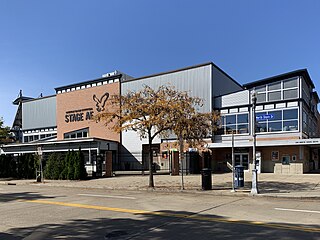
The Boston Garden was an arena in Boston, Massachusetts. Designed by boxing promoter Tex Rickard, who also built the third iteration of New York's Madison Square Garden, it opened on November 17, 1928, as "Boston Madison Square Garden" and outlived its original namesake by 30 years. It was above North Station, a train station which was originally a hub for the Boston and Maine Railroad and is now a hub for MBTA Commuter Rail and Amtrak trains.

The Spectrum was an indoor arena in Philadelphia, Pennsylvania. The arena opened in September 1967 as part of what is now known as the South Philadelphia Sports Complex. After several expansions of its seating capacity, it accommodated 18,168 for basketball and 17,380 for ice hockey, arena football, indoor soccer, and box lacrosse.

The Purdue Boilermakers are the official intercollegiate athletics teams representing Purdue University, located in West Lafayette, Indiana. As is common with athletic nicknames, the Boilermakers nickname is also used as colloquial designation of Purdue's students and alumni at large. The nickname is often shortened to "Boilers" by fans.

Ross–Ade Stadium is a stadium in West Lafayette, Indiana, on the campus of Purdue University. It is the home field of Purdue Boilermakers football.

The Ford Idaho Center is a complex of sports and entertainment venues in Nampa, Idaho, approximately 15 miles (24 km) west of Boise.

St. John Arena is a multi-purpose arena on the campus of Ohio State University in Columbus, Ohio, United States. The arena was named for Lynn St. John, who served as Ohio State's men's basketball coach and athletic director until 1947. It was designed by Howard Dwight Smith, architect of Ohio Stadium. It opened in 1956 to serve as the home of multiple Buckeye athletic teams, primarily the men's basketball team. Prior to its construction, the men's basketball team played off-campus in the Fairgrounds Coliseum at the state fairgrounds. St. John Arena served as home of the men's and women's basketball teams until it was replaced by Value City Arena in 1998, while the remaining tenants moved to the Covelli Center in 2019. It is still occasionally used by the men's and women's basketball teams for games and is used before every OSU football home game for The Ohio State University Marching Band's Skull Session.

The Purdue "All-American" Marching Band is the marching band of Purdue University and performs at Purdue Boilermakers football games. The AAMB is also the official band of the Indianapolis 500 race, having held the position since 1919.

The Purdue Grand Prix is a go-kart race that has been held annually by Purdue University in West Lafayette, Indiana, since May 17, 1958. It is known as "the Greatest Spectacle in College Racing." It hosts approximately 3,500 live spectators per year, with many more watching televised or streamed broadcasts. The primary function of the event is to raise money for Purdue student scholarships under the aegis of the Purdue Grand Prix Foundation and its motto: 'Students Helping Students.' Though the race is traditionally held on a Saturday, associated festivities, parties, parades, and other events, both sanctioned and unsanctioned, begin the weekend before and are held throughout the week. Grand Prix is also a large event for alumni who often return to campus for the weekend.

Lambert Fieldhouse is an athletic facility on the campus of Purdue University in West Lafayette, Indiana. It was built in 1937 on land bought by David Ross and George Ade as a replacement for Memorial Gymnasium to be the home of the Purdue basketball team, and also contained an indoor track. Memorial Gym was a 2,000 seat facility built in 1910 which had outgrown its usefulness, as the team had even resorted to playing games at the local high school gym, which seated twice as many as the gym did. In 1967, the team moved into the newly built Mackey Arena next door, and the building was remodeled to become a full-time track facility. The building also contains pool facilities, which were in use by the swimming and diving teams until 2001, when the Boilermaker Aquatic Center was completed.

Gator Growl, produced by Florida Blue Key with artists funded by Student Government Productions, is a student-run pep rally at the University of Florida that was founded in 1924. It marks the culmination of Homecoming Week at the university.

The Purdue Big Bass Drum is a percussion instrument played by the All-American Marching Band (AAMB) of Purdue University. At a height of over ten feet when the carriage is included, it is branded by Purdue as the "World's Largest Drum". Since its inception, it has become a lasting symbol of the marching band as well as the university. The drum can be seen at all Purdue home football games as well as parades, alumni rallies, the Indianapolis 500 Race, and many other special events.
Lambert Field was a baseball stadium in West Lafayette, Indiana. It was the home field of the Purdue Boilermakers baseball from 1965 until 2012 and held 1,100 people. It was named after former Purdue baseball coach Ward Lambert.

The Thunder of the East is the marching band of the University at Buffalo in the State University of New York system. UB's first marching band was created in 1920, and disbanded in 1927. It was revived in 1946, increasing in size and reputation until about 1970. It was known as "The Pride of the East." At that time, it was dissolved upon UB's departure from Division I athletics. In 1981, some UB students continued the tradition of playing music at UB's home football and basketball games by forming UB's Pep Band. In anticipation of UB's return to Division I athletics, a marching band was formed in 1999 and named, "Thunder of the East." The band debuted at the University at Buffalo Stadium on September 11, 1999. The Thunder of the East is currently led by James E. Mauck; and performs at UB's Buffalo Bulls home football games, as well as in other musical venues.

Stage AE is a multi-purpose entertainment complex located in Pittsburgh, Pennsylvania, United States. It contains an indoor concert hall and an outdoor amphitheatre. It is the second indoor/outdoor concert venue in America. Modeled after its predecessor, Express Live! in Columbus, the venue features state-of-the-art lighting, acoustical systems and an innovative reversible stage. Structurally, it is divided into three independent concert spaces: a music hall, club and outdoor amphitheater.
The 1984 Purdue Boilermakers football team represented Purdue University during the 1984 Big Ten Conference football season. Led by third-year head coach Leon Burtnett, the Boilermakers compiled an overall record of 7–5 with a mark of 6–3 in conference play, tying for second place in the Big Ten. Purdue was invited to the Peach Bowl, where the Boilermakers lost to Virginia. The team played home games at Ross–Ade Stadium in West Lafayette, Indiana. The Boilermakers defeated Notre Dame, Ohio State, and Michigan in the same season for the first and only time in college football history.
The 1995 Purdue Boilermakers football team represented Purdue University as a member of the Big Ten Conference during the 1995 NCAA Division I-A football season. Led by fifth-year head coach Jim Colletto, the Boilermakers compiled an overall record of 4–6–1 with a mark of 2–5–1 in conference play, placing ninth in the Big Ten. Purdue played home games at Ross–Ade Stadium in West Lafayette, Indiana.
The 1991 Purdue Boilermakers football team represented Purdue University as a member of the Big Ten Conference during the 1991 NCAA Division I-A football season. Led by first-year head coach Jim Colletto, the Boilermakers compiled an overall record of 4–7 with a mark of 3–5 in conference play, tying for sixth place the Big Ten. Purdue suffered its seventh consecutive losing season. The team played home games at Ross–Ade Stadium in West Lafayette, Indiana.
The 1989 Purdue Boilermakers football team represented Purdue University as a member of the Big Ten Conference during the 1989 NCAA Division I-A football season. Led by third-year head coach Fred Akers, the Boilermakers compiled an overall record of 3–8 with a mark of 2–6 in conference play, placing eighth in the Big Ten. It was Purdue's fifth straight losing season. The team played home games at Ross–Ade Stadium in West Lafayette, Indiana.
David Edward Ross was a Purdue University graduate who helped advance the university through his generous donations and years of service on the board of trustees.

The Clemson University Tiger Band serves as the Marching Band, Color Guard, Tiger Dancers and Tiger Twirlers of Clemson University. The marching band component of the band is made up of wind instruments, percussion, and auxiliary units, including the piccolo, clarinet, alto saxophone, tenor saxophone, trumpet, horn, trombone, baritone, and sousaphone. To the thousands of fans, it is known as the Tiger Band, or better yet the "band that shakes the Southland". Composed of over 300 members, Tiger Band's mission is to provide inspiring spirit and entertainment to not only the university, but beyond.















